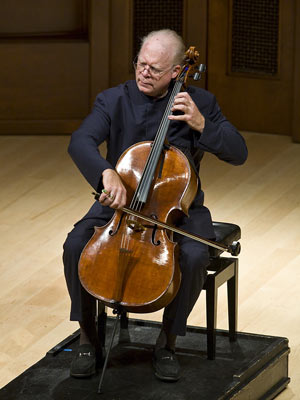Lynn Harrell
At Hahn Hall, Saturday, November 15.
In the realm of generally acknowledged landmarks of the classical music repertoire, the Bach Cello Suites have achieved such a lofty status that it can be difficult to recognize that the pieces, which were composed in 1720, languished in relative neglect, and were considered study pieces for almost 200 years, until Pablo Casals brought them to concert life just a century ago, in 1909. They were, like Bach’s Well-Tempered Clavier, designated as etudes, but they were revealed to be worthy of intense focus and meditation, from the perspectives of both players and listeners.

Lynn Harrell, clearly one of the great living cellists, reminded us of the full glory and depth of the Suites at the Music Academy of the West’s Hahn Hall on Saturday afternoon, as part of UCSB’s Pearl Chase Society series of concerts. Normally, the series lands in different unconventional but architecturally notable sites throughout the year. This season, however, all the events are scheduled for the newly launched Hahn Hall. Harrell’s performance, of the first, third, and deeper, darker-toned fifth suites, was stunning and sublime. He brought a technical mastery and lucidity to the music, but, where required, he was also rough and ready, thereby reviving the dance factor implicit in the suite’s structures.
From the first signature arpeggios of the first suite’s prelude to the last tones of the fifth, we got the sense of entering a precious sanctum in musical culture. It’s a complete world, by turns somber and jubilant, and teeming with Bach’s ingenuity and invention within a fairly strict formal package. Harrell described the well-known first suite, as “outdoorsy and nature-oriented,” while the third suite is more “majestic.” He dedicated his performance of the third to “those who have suffered this week.” Many in the audience were, in fact, evacuees from the Tea Fire. He might just as well have dedicated the fifth suite, a weightier affair in C minor, and a model of stern beauty. Compared to the dense sonic textures surrounding it, the hushed, worshipful airiness of the Sarabande had a mesmerizing effect, becoming a prayer in sound.
If there was any misstep in Harrell’s performance, it was his decision to end with a witty lark by Hindemith as the final encore. That was the only distraction from the rare and hypnotic dimension that is this Bach masterpiece, masterfully realized in this room on this afternoon.



